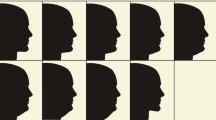Abstract
Introduction
There are few, controversial, and limited studies on factors associated with the perception of profile beauty. Moreover, no study has ever assessed the role of laterality in esthetic judgment. Hence, this clinical trial was conducted.
Methods
Photographs of 6 patients (3 women) with normal lip position (Ricketts norm = 0 mm) and facial convexity (Legan-Burstone norm = 12°) were digitally manipulated to create two series of 9 gradient images each, with convexity changes of 2° and anteroposterior lip modifications of 1 mm. Half of profiles were flipped horizontally. Laypeople (n = 35), orthodontists (n = 19), and maxillofacial surgeons (n = 10) selected the esthetically acceptable images (6912 esthetic evaluations [2 parameters × 6 sets × 9 images × 64 judges]). Effects of photogrammetric stimuli and other factors on judges’ zone of esthetical acceptability (ZA) and its midrange were assessed statistically (α = 0.05).
Results
Orthodontists and surgeons had respectively the broadest and narrowest ZAs (p < 0.05, ANOVA). Mean midranges of surgeons, orthodontists, and laypeople were respectively 0.27 ± 1.35, 0.56 ± 1.46, and 0.41 ± 1.77 mm for males’ lower lips (p = 0.710, ANOVA); 0.27 ± 1.10, − 0.44 ± 0.91, and 0.03 ± 1.56 mm for females’ lower lips (p = 0.034); 10.40 ± 3.17°, 11.09 ± 2.86°, and 11.57 ± 3.84° for men’s profile convexity (p = 0.246); 10.27 ± 3.20°, 11.05 ± 1.87°, and 11.13 ± 3.26° for women’s profile convexity (p = 0.346). Judges’ gender did not affect their esthetic perception (p > 0.1). When patients’ left side of face was visible, judges’ esthetic preference parameters shifted towards a less convex profile and a narrower ZA (p < 0.05).
Conclusion
Slightly protruded lips (for men) and slightly less convex profiles (for men/women) might be favored by all groups. Women’s esthetic lip positions might differ among groups. Judges’ gender might not be a determinant. Subjects’ face side can influence judges’ esthetic perception of facial convexity.


Similar content being viewed by others
References
Massad JJ (1999) A perspective on dental beauty. Dent Today 18:46–49
Sodagar A, Borujeni DG (2013) Evaluation of anteroposterior lip positions in the most-favored iranian facial profiles using silhouette. J Dent (Tehran, Iran) 10:393–404
Berneburg M, Dietz K, Niederle C, Goz G (2010) Changes in esthetic standards since 1940. Am J Orthod Dentofac Orthop 137(450):e1–e9 discussion −1
Matoula S, Pancherz H (2006) Skeletofacial morphology of attractive and nonattractive faces. Angle Orthod 76:204–210
Nguyen DD, Turley PK (1998) Changes in the Caucasian male facial profile as depicted in fashion magazines during the twentieth century. Am J Orthod Dentofac Orthop 114:208–217
Nomura M, Motegi E, Hatch JP, Gakunga PT, Ng'ang'a PM, Rugh JD et al (2009) Esthetic preferences of European American, Hispanic American, Japanese, and African judges for soft-tissue profiles. Am J Orthod Dentofac Orthop 135:S87–S95
Khosravanifard B, Rakhshan V, Raeesi E (2013) Factors influencing attractiveness of soft tissue profile. Oral Surg Oral Med Oral Pathol Oral Radiol 115:29–37
Cox NH, van der Linden FPGM (1971) Facial harmony. Am J Orthod 60:175–183
Cross JF, Cross J (1971) Age, sex, race, and the perception of facial beauty. Dev Psychol 5:433–439
Martin JG (1964) Racial ethnocentrism and judgment of beauty. J Soc Psychol 63:59–63
Hickman L, Firestone AR, Beck FM, Speer S (2010) Eye fixations when viewing faces. J Am Dent Assoc 141:40–46
Giddon DB (1995) Orthodontic applications of psychological and perceptual studies of facial esthetics. Semin Orthod 1:82–93
Shimomura T, Ioi H, Nakata S, Counts AL (2011) Evaluation of well-balanced lip position by Japanese orthodontic patients. Am J Orthod Dentofac Orthop 139:e291–e2e7
Schlosser JB, Preston CB, Lampasso J (2005) The effects of computer-aided anteroposterior maxillary incisor movement on ratings of facial attractiveness. Am J Orthod Dentofac Orthop 127:17–24
Celebi AA, Tan E, Gelgor IE, Colak T, Ayyildiz E (2013) Comparison of soft tissue cephalometric norms between Turkish and European-American adults. Sci World J 2013:806203
Hassebrauck M (1998) The visual process method: a new method to study physical attractiveness. Evol Hum Behav 19:111–123
Sukhia RH, Khan M, Fida M, Shaikh A, Azam SI (2011) Esthetic preferences for facial soft tissue profiles. Int J Orthod Milwaukee 22:17–23
Naini FB, Donaldson ANA, McDonald F, Cobourne MT (2012) Assessing the influence of chin prominence on perceived attractiveness in the orthognathic patient, clinician and layperson. Int J Oral Maxillofac Surg 41:839–846
McKoy-White J, Evans CA, Viana G, Anderson NK, Giddon DB (2006) Facial profile preferences of black women before and after orthodontic treatment. Am J Orthod Dentofac Orthop 129:17–23
Miner RM, Anderson NK, Evans CA, Giddon DB (2007) The perception of children’s computer-imaged facial profiles by patients, mothers and clinicians. Angle Orthod 77:1034–1039
Ioi H, Shimomura T, Nakata S, Nakasima A, Counts AL (2008) Comparison of anteroposterior lip positions of the most-favored facial profiles of Korean and Japanese people. Am J Orthod Dentofac Orthop 134:490–495
Ioi H, Nakata S, Nakasima A, Counts AL (2005) Anteroposterior lip positions of the most-favored Japanese facial profiles. Am J Orthod Dentofac Orthop 128:206–211
Mantzikos T (1998) Esthetic soft tissue profile preferences among the Japanese population. Am J Orthod Dentofac Orthop 114:1–7
Ghorbanyjavadpour F, Rakhshan V (2019) Factors associated with the beauty of soft-tissue profile. Am J Orthod Dentofacial Orthop 155:832–843
Erbay EF, Caniklioglu CM (2002) Soft tissue profile in Anatolian Turkish adults: part II. Comparison of different soft tissue analyses in the evaluation of beauty. Am J Orthod Dentofac Orthop 121:65–72
Ricketts RM (1957) Planning treatment on the basis of the facial pattern and an estimate of its growth. Angle Orthod 27:14–37
Legan HL, Burstone CJ (1980) Soft tissue cephalometric analysis for orthognathic surgery. J Oral Surg 38:744–751
Jacobson A, Jacobson RL (2007) Radiographic cephalometry: from basics to 3-D imaging, 2nd edn. Quintessence, Hanover Park, IL
Spyropoulos MN, Halazonetis DJ (2001) Significance of the soft tissue profile on facial esthetics. Am J Orthod Dentofac Orthop 119:464–471
Romani KL, Agahi F, Nanda R, Zernik JH (1993) Evaluation of horizontal and vertical differences in facial profiles by orthodontists and lay people. Angle Orthod 63:175–182
Arpino VJ, Giddon DB, BeGole EA, Evans CA (1998) Presurgical profile preferences of patients and clinicians. Am J Orthod Dentofac Orthop 114:631–637
Nicholls ME, Loftus A, Mayer K, Mattingley JB (2007) Things that go bump in the right: the effect of unimanual activity on rightward collisions. Neuropsychologia 45:1122–1126
Pisella L, Alahyane N, Blangero A, Thery F, Blanc S, Pelisson D (2011) Right-hemispheric dominance for visual remapping in humans. Philos Trans R Soc Lond Ser B Biol Sci 366:572–585
Czarnecki ST, Nanda RS, Currier GF (1993) Perceptions of a balanced facial profile. Am J Orthod Dentofac Orthop 104:180–187
Lew KK, Ho KK, Keng SB, Ho KH (1992) Soft-tissue cephalometric norms in Chinese adults with esthetic facial profiles. J Oral Maxillofac Surg 50:1184–1189 discussion 9-90
Peck H, Peck S (1970) A concept of facial esthetics. Angle Orthod 40:284–318
Sforza C, Laino A, D'Alessio R, Grandi G, Tartaglia GM, Ferrario VF (2008) Soft-tissue facial characteristics of attractive and normal adolescent boys and girls. Angle Orthod 78:799–807
Turkkahraman H, Gokalp H (2004) Facial profile preferences among various layers of Turkish population. Angle Orthod 74:640–647
Jones D, Hill K (1993) Criteria of facial attractiveness in five populations. Hum Nat 4:271–296
Hemmatpour S, Kadkhodaei Oliadarani F, Hasani A, Rakhshan V (2016) Frontal-view nasolabial soft tissue alterations after bimaxillary orthognathic surgery in class III patients. J Orofac Orthop 77:400–408
Hershon LE, Giddon DB (1980) Determinants of facial profile self-perception. Am J Orthod 78:279–295
Acknowledgments
The authors express their sincere gratitude to Prof. Donald B. Giddon for his in-depth review of the methods, statistics, and article as well as his extensive contributions and edit to the text.
Author information
Authors and Affiliations
Corresponding author
Ethics declarations
Conflict of interest
The authors declare that they have no conflicts of interest.
Ethical approval
All procedures were in accordance with the ethical standards of the institutional research committee and with the 1964 Helsinki declaration and its later amendments.
Informed consent
Informed consent was obtained from orthodontic patients.
Additional information
Publisher’s note
Springer Nature remains neutral with regard to jurisdictional claims in published maps and institutional affiliations.
Rights and permissions
About this article
Cite this article
Mousavi, S.M., Saeidi Ghorani, P., Deilamani, A. et al. Effects of laterality on esthetic preferences of orthodontists, maxillofacial surgeons, and laypeople regarding the lip position and facial convexity: a psychometric clinical trial. Oral Maxillofac Surg 23, 439–451 (2019). https://doi.org/10.1007/s10006-019-00795-w
Received:
Accepted:
Published:
Issue Date:
DOI: https://doi.org/10.1007/s10006-019-00795-w




